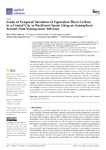Study of Temporal Variations of Equivalent Black Carbon in a Coastal City in Northwest Spain Using an Atmospheric Aerosol Data Management Software

Use this link to cite
http://hdl.handle.net/2183/27315
Except where otherwise noted, this item's license is described as Atribución 4.0 Internacional (CC BY 4.0)
Collections
- Investigación (FCIE) [1227]
Metadata
Show full item recordTitle
Study of Temporal Variations of Equivalent Black Carbon in a Coastal City in Northwest Spain Using an Atmospheric Aerosol Data Management SoftwareAuthor(s)
Directors
Date
2021-01-07Citation
Piñeiro-Iglesias, M.; Andrade-Garda, J.; Suárez-Garaboa, S.; Muniategui-Lorenzo, S.; López-Mahía, P.; Prada-Rodríguez, D. Study of Temporal Variations of Equivalent Black Carbon in a Coastal City in Northwest Spain Using an Atmospheric Aerosol Data Management Software. Appl. Sci. 2021, 11, 516. https://doi.org/10.3390/app11020516
Abstract
[Abstract]
Light-absorbing carbonaceous aerosols (including black carbon (BC)) pose serious health issues and play significant roles in atmospheric radiative properties. Two-year measurements (2015–2016) of aerosol light absorption, combined with measurements of sub-micrometric particles, were continuously conducted in A Coruña (northwest (NW) Spain) to determine their light absorption properties: absorption coefficients (σabs) and the absorption Ångström exponent (AAE). The mean and standard deviation of equivalent black carbon (eBC) during the period of study were 0.85 ± 0.83 µg m−3, which are lower than other values measured in urban areas of Spain and Europe. High eBC concentrations found in winter are associated with an increase in emissions from anthropogenic sources in combination with lower mixing layer heights and frequent stagnant conditions. The pronounced diurnal variability suggests a strong influence from local sources. AAE had an average value of 1.26 ± 0.22 which implies that both fossil fuel combustion and biomass burning influenced optical aerosol properties. This also highlights biomass combustion in suburban areas, where the use of wood for domestic heating is encouraged, as an important source of eBC. All data treatment was gathered using SCALA© as atmospheric aerosol data management support software program.
Keywords
Equivalent black carbon
Absorption Ångström exponent
Ultrafine particles
Biomass burning
SCALA© platform
Absorption Ångström exponent
Ultrafine particles
Biomass burning
SCALA© platform
Editor version
Rights
Atribución 4.0 Internacional (CC BY 4.0)
ISSN
2076-3417






